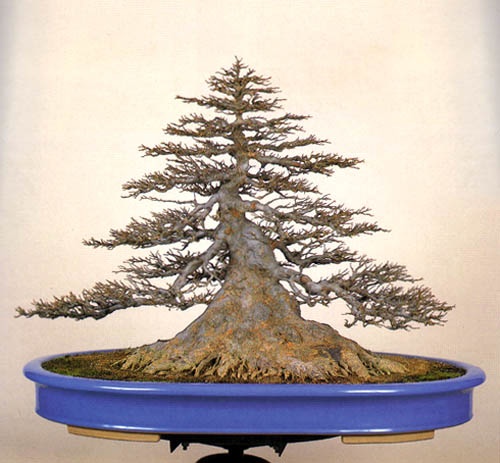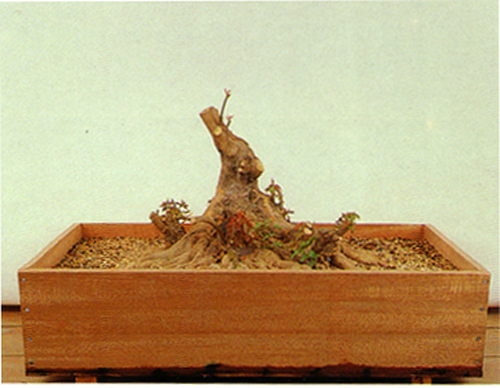 This impressive Trident maple’s (Acer buergeranum) massive nebari is a dead giveaway that it was field grown. The original article is in Bonsai Today issue 64.
This impressive Trident maple’s (Acer buergeranum) massive nebari is a dead giveaway that it was field grown. The original article is in Bonsai Today issue 64.
I once read a report from Cornell University (I can’t find it; anybody?) about the advantages of planting trees directly into the native soil, rather than the common practice of digging in soil amendments, a practice that may be good for the garden center’s bottom line, but not so good for your plants.
If you think about it, it makes sense; if you create a pocket of richer soil, then the roots tend to stay in that pocket. In the not-so-long-run, this causes slower growth and increased susceptibility to drought and winter kill (this may be more relevant to landscape planting than to field growing bonsai, but in my case it works for both).
Ever since I read the Cornell report, I’ve been simply digging a hole and planting. What a relief! No tedious time consuming soil prep. This frees me up to plant more and do other things I enjoy.
 The same Trident maple fifteen years earlier, right after it was dug from the field. At this point the nebari measure 20″ (51cm) at its widest point.
The same Trident maple fifteen years earlier, right after it was dug from the field. At this point the nebari measure 20″ (51cm) at its widest point.
I’m lucky that my soil is sandy so I don’t have to worry about drainage; it can rain as much as it wants and I can water to my heart’s content. If your soil is heavy and doesn’t drain so well, then it’s time to think about raised beds, but that’s a topic for another post.
Sandy soil also makes fertilizing easier. Basically, you can feed freely. I like organic ferts, so I buy various locally produced stuff (and sometimes fish/seaweed and other mild liquids) and just sprinkle it on the soil and let it leach down to the roots.
Even if you use harsh chemicals you can fertilize fairly liberally if you have good drainage, because the drainage insures that there won’t be excessive build up of chemicals around the roots.
Enough for now. Stay posted.
Check out our previous post on field growing Have You Thought About Field Growing?
Ok, that’s great… but what if you have heavy clay soil that doen’t drain and doesn’t allow root to expand very well? Up here in the northwest, the only way I’ve seen field growing work is to 1)create a raisd bed with amended soil, or 2)to amend the soil “hole” before placing the tree. Question though… do you wire the tree root base to a plate or a tile or use some other method to keep from developing the major taproot?
Thanks,
brian
Another good way to maintain and improve soil fertility is to inter-crop with legumes and grasses which will add soil N and organic matter respectively. Additionally, inter-crops can displace weeds if managed properly. One only needs to ensure that the inter-crops do not take any light or water resources from the trees.
It would seem to me that if the native soil has a dense clay consistency then simply placing a tree into it might have a negative effect on its health growth. The dense clay would hold a great deal of moisture whoch may be more harmful to the roots in the long or short term. At the same time, a pocket of well draining soil in such a native would also have negative possibilities as well. Those who have sandy or gravel native soil are more likely to have the best results using native soil for trees in the ground for the reasons that are suggested, but not everyone is so lucky.
Clay soils are not always bad. In fact some trees prefer clay soils (not in a pot though). Clay soils do not need to be watered as often as sany soils. Clay soils have a higher nutrient holding capacity than sandy soils, therefore less fertilizer. Like sandy soils, clay soils need management. Dylan Ferreira is correct, the more organics one has in clay soils the better. I live and hour or so from the Sprinbok Flats, a vast area of heavy black clay where sorgum and sunflowers are grown. These farmers manage their clay with zero or minimum till. They do not turn the soil but leave crop roots and stubble in the soil. Next years crop is planted between the stubble. This keeps the clay open and friable. Try not to work wet clay, wait for it to dry a bit. Use mulch to encourage surface feeding and try some Gypsum (Calcium Sulphate) as a treatment.
Brian, yes, clay soil presents certain challenges. We’ll have more later, but meanwhile check out Roger Stone’s post above.
Thanks Dylan. I haven’t tried, though I’ve heard good things. Keep us posted.
Brian and Dick, yeah I’m lucky that I have sandy soil, and even luckier that it has enough organic matter in it to simply plant, water and stand back. I don’t even have to fertilize, but I do.
Anyway, Roger has some good tip (see above) and we’ll have more.
The other aspect of organic matter (OM) that I think Roger Stones aluded to is that in addition to maintaining soil fertility, it helps to build and maintain soil structure, leading to improved aeration, water percolation and thus root growth. In general soil physical and chemical properties can be improved by OM inputs.
Also, about soil texture, there is a very wide spectrum ranging from pure clay to pure sand. I have had fantastic results growing trees in clay loam, a pretty clayey soil.
When planting any sort of tree in the ground I prefer to use a digging fork. A digging fork breaks the soil up when it is pried out of the ground, leaving rough sides in the hole. A shovel on the other hand shears the soil, leaving the sides of the hole smooth and creating a pot in the ground that can lead to restriction of growing tree roots.
Here in Western New York State, there is a high degree of gravel below most of the topsoil in fields. Farmers often leave the stubble of crops from the previous year and just lightly disk the field before planting. However, there are also large areas where the subsoil is a dense gray clay. It’s often used to line ponds and other water holding areas because of its density. That’s certainly not the kind of clay that woud be beneficial for trees. As a matter of fact, it can be worked to get the impurities out of it and then fired in a kiln to make a clay pot if necessary. In areas where there is such clay, trees are often missing and only scrub field grasses and moss grow on the surface. I don’t think that this kind of clay would be suitable at all and so the hole or raised bed with amended soil is probably the best choice.
my experience has been that of root rot. Clay just seems to trap a large amount of water and does not allow the roots to breathe, i do agree that it does keep nutrients intact for a longer time but i think the use of OM [ we get coconut fibre as peat ] top soil and around the root ball does well.
i love your blog its great . would love to hear about Tropical plants too…
a sinha and all,
Thanks for the kind words and insights. There is a lot of good information in your posts. I’m way on board with the emphasis on organic matter in soil. Both clay and sand can be greatly improved by the addition of OM. Because I’m a little lazy and because the sandy soil here has some organic matter already, I just keep top dressing and let the particles leach into the soil. A gardener friend who I respects, says that’s not enough, that I should dig the organic matter into the soil. Still, my lazy man’s results are pretty good.
I recently came across your blog and have been reading along. I thought I would leave my first comment. I don’t know what to say except that I have enjoyed reading. Nice blog. I will keep visiting this blog very often.
Margaret
http://howtomakecompost.info
Thank you. We’ll try to keep it interesting for you.
Have bee studying various types of topsoil but am unsure about how the certification works,does anyone know what
different types of grading mean,
or is ther a site dedicated to this subject.
I have questions? I am currently preparing a small land for field planting. 1) Is there an ideal spacing between trees? 2) Does one place the “root spreader? e.g. tile, immediately upon seedling/treeling planting and, if so, what depth seems to work best?
Thanks.
How far apart you plant your small trees will depend upon the type of tree, how developed it is when you plant it (at least two years old is recommended for seedlings and cuttings) and how long you plan on growing it before you dig it up and prune and spread the roots. The longer you let it grow without disturbance, the better for thickening trunks. However, if you want to develop a nebari (this is particularly important on most deciduous trees), you can’t let it grow too long. Three to four years might be a pretty good (but flexible) rule of thumb.
When I start with very small plants, I allow about 12″ (30cm) for slow to moderate growth plants. For larger and rapid growth plants you want to allow considerably more space. How much depends upon the type of plant (does it spread or grow vertically) and how long you plan to let them grow before you dig them up.
This first transplanting is a good time to place your tiles. How much soil you place on top of the tile depends upon the size of the tree, how thick and developed the roots already are, and other factors (like how fast your soil dries out). About 3 inches (5cm) for an average medium size plant might be a rough starting point. If you choose not to use tiles, you still want to prune and spread the roots when you dig.
Because there are infinite variables, it’s impossible to come up with hard and fast rules. Climate, type of soil, type of plants and your needs and tendencies are all factors that need to be considered. You may need to experiment for a while to see what works for you.
Thank you Wayne – much appreciated.
thanks for the great quality of your blog, each time i come here, i’m amazed.